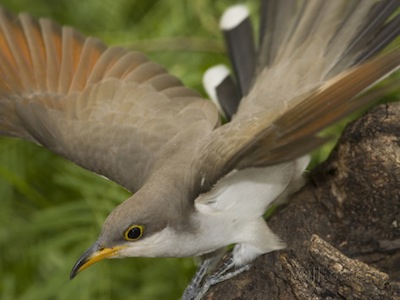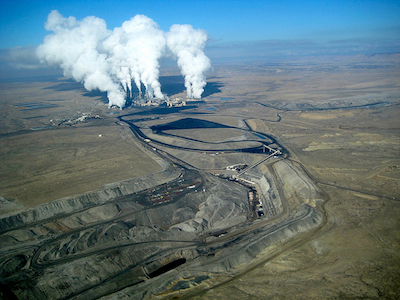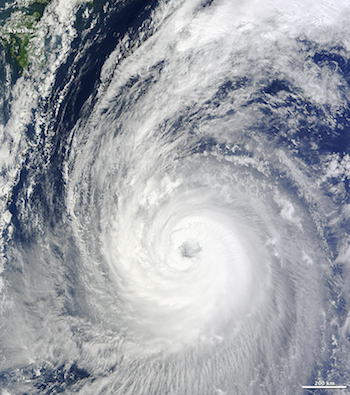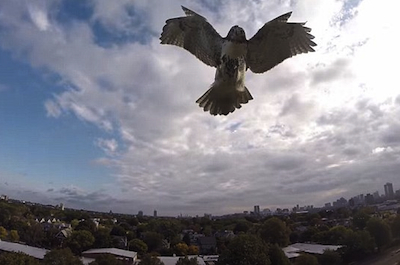Dear Friend and Reader:
Yellow-billed cuckoos, native to the western U.S., are to be listed as threatened with extinction, enabling the government to protect them, the Center for Biological Diversity announced Oct. 3. Critics have labeled the decision “a blatant abuse of the Endangered Species Act,” due in part to its potential negative effect on the Salt River Project, which provides electricity for millions of Arizona residents.

Yellow-Billed Cuckoo (Coccyzus Americanus) displaying in the Rio Grande Valley, Texas; its status as a threatened species covers portions of 12 western states. Photo by Tom Vezo.
The building of dams for the Salt River Project, along with increased acreage devoted to agriculture and the spread of invasive species, have contributed to the marked decline of the yellow-billed cuckoos ‘ natural wetland habitats. The bird’s population has consequently dropped over several decades.
Steve Spangle, from the U.S. Fish and Wildlife Service in Arizona, said the organization was “looking forward to working with all the agencies” to protect the species.
A large part of one newly designated critical habitat was being threatened by the prospect of a mine, suggesting that the species’ new designation may be heading off more ecological harm than usual — though not everyone sees it that way.
Left unmentioned in most discussion of the yellow-billed cuckoo’s new designation and the local waterways is that the Salt River Project was home to one of the first massive domestic uses of Agent Orange herbicides, intended to facilitate water flow into the Salt River. From 1965-1969, the U.S. Forest Service repeatedly sprayed the whole area by helicopter, including rivers, streams and people’s homes, with the same mixture of 2,4-D and 2,4,5-T used in Vietnam. (The New York Times covered residents’ settlement with Dow Chemical in 1981.)
Said toxic chemicals researcher Carol Van Strum in a comment to Planet Waves, “For a truly mind-boggling account of that insanity, see Sue the Bastards! by Billee Shoecraft. The Salt River Project itself is a prime example of how entire populations are led to depend on environmentally destructive, unsustainable projects.”
Fossil Fuel Harvesting Creates Methane Hot Spot
In other news from the Southwest, researchers using satellite data have discovered a small area in the southwestern U.S. where significantly more methane is produced than in the rest of the country. The “hot spot,” reported by NASA Oct. 9, is on the Colorado-New Mexico border, close to the intersection with Arizona and Utah, and covers approximately 2,500 square miles.

The San Juan Generating Station and mine. Photo by San Juan Citizens’ Alliance / EcoFlight under Creative Commons license.
With emissions seeming to reach about 100,000 metric tons of methane per year, the main suspect is a large coalbed methane factory in the San Juan Basin.
Lead study author Eric Kort explained that fracking does not explain the data from 2003-2009, and that the results suggest “emissions from established fossil fuel harvesting techniques are greater than inventoried.”
Widespread Aquifer Poisoning in Central California
Fracking has, however, proven a culprit in the poisoning of California groundwater. State documents obtained by The Center for Biological Diversity reveal widespread contamination of Central California aquifers by almost 3 billion gallons of oil industry wastewater, reported The Center on Oct 6.
The waste, contaminated with fracking fluids and other pollutants, entered through at least nine injection disposal wells used by the oil industry for disposal of waste. Tests conducted by the Central Valley Water Board have shown high levels of toxic arsenic, thallium and nitrates in wells near these waste-disposal operations.
“The fact that high concentrations are showing up in multiple water wells close to wastewater injection sites raises major concerns about the health and safety of nearby residents,” said Timothy Krantz, a professor of environmental studies at the University of Redlands.
Typhoon Rains Elevate Fukushima Radiation Levels
Sticking with the theme of contaminated water a little longer, heavy rains from Typhoon Phanfone, a storm that swept through eastern Japan last week, may have caused a surge in radiation levels at the Fukushima Daiichi nuclear power plant. The Japan Times reported Oct. 12 that Tokyo Electric Power Company (TEPCO) discovered record-high levels of radioactive substances from groundwater samples in three wells that are periodically tested.

Natural-color view of the category 3 Typhoon Phanfone taken by NASA’s Terra satellite on Oct. 3. Near the time of this image, maximum sustained winds were estimated at 204 kilometers (127 miles) per hour, with maximum significant wave height at 13 meters (44 feet).
A TEPCO spokesperson stated that the typhoon may have had an effect, while TEPCO itself claims it does not know why. With another storm heading towards Fukushima this week, water migrations from the plant into the ocean may be possible as well as delays in the cleanup of the crippled plant.
“Operator TEPCO revealed the findings as Prime Minister Shinzo Abe and his government tried to reassure the international community that the situation at Fukushima is ‘under control,'” according to Yahoo! News.
Some would argue that nothing about the Fukushima situation has been “under control” in more than three years.
Upper Ocean Levels Warmer Than Previously Calculated
Water — so essential for life on Earth — is a barometer for the health of the planet on the macro scale as well as in more localized ecosystems. Climate scientists, keenly focused on ocean temperatures, have found that the effect of global warming on the upper 2000 meters of the world’s oceans is greater than science has previously calculated, according to the Oct. 6 New York Times.
Citing a recent study published by Lawrence Livermore National Laboratory, the Times quoted study leader Paul Durack as saying, “We potentially may have missed a fair amount of heat the ocean has been taking up.”
Interestingly, a study concurrently published by NASA’s Jet Propulsion Laboratory (JPL) indicates that deeper ocean layers have not warmed in proportion. But as JPL researcher Felix Landerer has noted, the warming of the oceans’ top half is “an unequivocal sign our planet is heating up.”
Animals Taking Action: The New Trend?
Given how well humanity has created dire environmental problems, one could hardly blame animals if they finally chose to take matters into their own hands — and a pair of videos that have taken the Internet by storm in the last few days illustrate what that might look like.
In the casual, “can’t we all just get along?” style of negotiation, we have a horse in Cheshire, England, who paid the local police headquarters a visit, captured on CCTV.

A hawk above Cambridge, Massachusetts, gets its point across. Drone operator Christopher Schmidt plans to donate any YouTube ad revenue from this video to the Audubon Society. Video still.
The equine visitor does not seem to have stayed long enough to file a report or press charges against any agricultural wrongdoers, so perhaps he’s just getting to know the neighbors the same way a beat cop might when assigned to a new neighborhood?
Said a Cheshire police spokesman in a statement reported by The Guardian, “At neigh point did the horse pose a risk to security.” If only the horse could say the same of us.
Meanwhile, a hawk above Cambridge, Massachusetts, took a more ‘vigilante justice’ approach when it encountered a recreational drone aircraft known as a quadcopter last week. Cambridgeport resident Christopher Schmidt just wanted to film the changing colors of the trees; the hawk, however, saw it as a direct threat.
“My turning the quadcopter, as you can see in the video, was an attempt to move away from the area that he was circling, since I had seen him in the park earlier,” Schmidt told Boston.com. “As he flew closer, I first thought ‘that will be an interesting shot.'”
The hawk succeeded in clearing his airspace, sending the drone thudding to the ground; neither the bird nor the quadcopter suffered damage.
No word as to whether the hawk will try harder next time.
Yours & truly,
![]()
Amanda Painter and the ECO editorial team
You may forward Planet Waves Monsanto Eco to your friends. They can sign up for this free environmental newsletter from Planet Waves. View this edition as a webpage.
Planet Waves Monsanto Eco (ISSN 1933-9135) is published each Tuesday evening in Kingston, New York by Planet Waves, Inc. Publisher: Eric Francis Coppolino. Editor: Amanda Painter. Business Manager: Chelsea Bottinelli. Web Developer: Anatoly Ryzhenko. Research, Writing and Editing: Planet Waves Monsanto Eco is produced by a team consisting of Amy Elliott, Carol van Strum, Len Wallick and Chad Woodward.


Along with the yellow-billed cuckoo and the hawk in the stories above, I’ve been made aware of the small flying creatures in my neighborhood of late who have been singing more than usual. Then there are the crows who scared my cat back into the apartment
The birds pull me back into my environment at a time when I’ve been narrowly and mentally focused.
Many thanks to Amanda and her team for an engaging and vital edition of “ECO” once again.